 Back in October or so we pondered about how to spend some quality time out in the country for a while. Some friends of ours had told us of their WorkAway experiences, so we gave it a try. We found a host running a BnB who were looking for some help with construction and sewing projects, and we volunteered to assist them for 5 hours/day, 5 days/week, in exchange for meals and lodging. Sweet! Plus, we had wanted to visit this corner of Spain, and venture into Portugal, so this arrangement made it really easy to kill 3 birds with one stone.
Back in October or so we pondered about how to spend some quality time out in the country for a while. Some friends of ours had told us of their WorkAway experiences, so we gave it a try. We found a host running a BnB who were looking for some help with construction and sewing projects, and we volunteered to assist them for 5 hours/day, 5 days/week, in exchange for meals and lodging. Sweet! Plus, we had wanted to visit this corner of Spain, and venture into Portugal, so this arrangement made it really easy to kill 3 birds with one stone.
Our stay at Finca Flores Amarillas was set for January 15-26. Portuguese tourism is pretty slow this time of year, and tickets from Barcelona to Porto were only about 20€ each, so we put Porto on our agenda, prior to arrival at the Finca. We decided to figure out our return to Barcelona later.
This post covers the two weeks we spent at the our workaway.
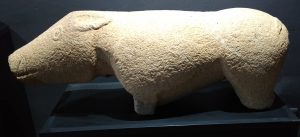
Finca Flores Amarillas is situated near the village of Almoharin, in the province of Caceres, autonomous region of Extremadura (see map). This region of Spain is known for being a hard place from which to wrest a living from the land, extremely hot and dry, and consequently, not much of a tourist draw. For those who do come, the landscape is vast, with great hiking and birdwatching opportunities, as well as many sites of cultural and historic interest. This area was also a significant player in the Roman empire – with Mérida as the capital of the Roman province of Lusitania, so named because they had to conquer the Lusitanians living here before gaining their foothold in the area.
For awhile, this area was awash in riches from the New World, because many escaped this region to seek their fortunes elsewhere, and ended up doing things like conquering Mexico and Peru. That day is long gone. Now, the area is celebrated by Spaniards for the fine hams produced here.

To get from Lisbon to Badajoz, we elected to take a slow regional train that seemed to hit every whistle-stop it could find. It was a single engine/coach affair – when we first saw it we puzzled over whether it was really the right train, but it got us where we were going, and the scenery was pleasant. Then we had about 6 minutes to disembark with our luggage and find the connecting train to Merida, where our host Paul was waiting to give us a lift the rest of the way to the finca. Paul is from Great Britain, and has been teaching English as a second language since finishing his university studies. Several members of Paul’s family also live in Almoharin, and we enjoyed meeting them several times over the course of our stay.
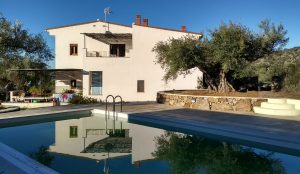
Iva and the 3 children met us at the finca when we arrived, got us settled in to our excellent accommodations, and then we discussed the plan for the next few weeks. Roy’s tasks: Design/build some patio/pool lounging benches based on some Pinterest photos + fix the henhouse gate. Teresa’s tasks: Sewing cushion covers for said benches, sewing curtains, tablecloths, napkins, etc … do some painting prep work, and a few other odd jobs. I should have taken pictures of the end results – they turned out pretty nice! Just think of this pic of the pool area, and pretend it had some benches for lounging – under the shade pavilion, just behind the photographer.
Daily Routine: Keep a low profile until the kids finish breakfast and head for school. School for them was a 2km hike – over the a few ancient stone walls, through a pasture and then onto some rural lanes to the village. They would always take their dog “Dina” along, and Iva would drive to the village a few minutes later with their backpacks and lunches, and to pick up Dina, then to her gig as a language teacher for adults. Iva teaches Spanish to British expats and English to Spaniards, depending on client needs. (She also teaches Slovenian to her kids, who, like Iva, are citizens of Slovenia.) After the kids left the house we would eat a light breakfast and start working about 9am. Coffee and biscuits about 11 or so, and back to work until 2:30pm when it’s time for lunch.
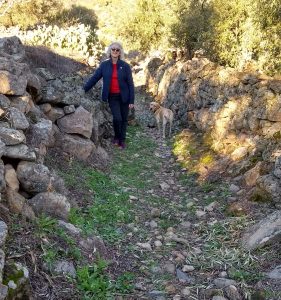
After lunch, our time is our own … maybe a nap for me, then perhaps a long walk with Teresa to explore the area.
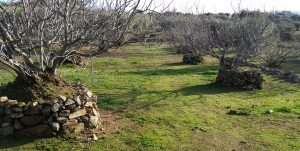
Turns out that Almoharin is the fig capital of Europe! I just consumed the last of the fig bonbons we purchased while there, and I am already missing them:( The area near the finca is quite rocky, with many ancient stone walls delineating property boundaries, fields and pastures. Historically, there have been a lot of sheep and goats pastured in the area, and more recently cattle. The pastures that I saw didn’t look all that lush, so I don’t know how they support all that stock, but I guess it works for them. Sometimes there are olive and fig trees in the pastures, with stone walls built around the tree trunks to prevent livestock damage. One day on our walk, we encountered the neighborhood Roman Bridge – smallish, but very sturdy. There are numerous other examples scattered around.
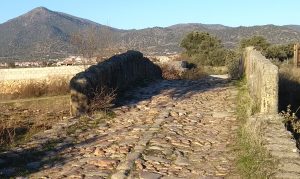
Our weekend off started after lunch on the first Friday. We took a bus from Almoharin to Caceres, walked 15 minutes from the bus station to the edge of the old town, and booked 2 nights at the Hotel Don Carlos. Old Cáceres is a remarkably well-preserved UNESCO World Heritage Site, but very quiet, as hardly anyone lives there. On Saturday morning, we walked back to the bus station to check out the rental car we had reserved for the remainder of our trip to the area. Once checked out, we found a convenient place to park near the hotel and just left it there until we were ready to leave town. In the afternoon we visited the ethnographic museum. This must be the 3rd or 4th time we’ve seen one in Spain. I have come to greatly appreciate attending them as we typically get a better appreciation for the local way of life back in the day… While at this one we saw great examples of using cork for utility household boxes and beehives. And here’s a link to a homemade mousetrap. Also learned that there used to be huge sheep/goat herd drives for 100’s of miles to this area for its winter pastures. One other item of interest – use of the local Dehesa landscape to combine cork oak forestry with grazing for pigs and other livestock. As we traveled about the area we saw many examples.
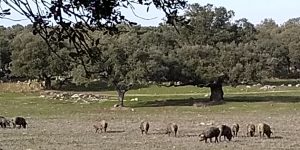
For lunch, we went to the Plaza Mayor, but found the fare quite uninspired. But there were a few shops in the area selling gastronomical goodies unique to the area. Lots of jamon and salchicha of course, but also beers brewed with acorns and chestnuts – even an acorn liqueur. In the evening we found a great tapas restaurant outside the boundaries of the old town – “Perhaps Tapería”.
Sunday morning we had a bit of breakfast and headed towards Mérida. En route, we passed a lot of those dehesa areas previously mentioned, and then got into the much flatter terrain around this town, well suited for agriculture and cris-crossed with irrigation channels. At one point we also passed a caravan of Romanis – something I remember seeing back in the early 70’s but apparently much rarer now.
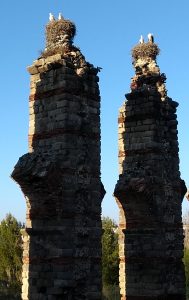
Present day Mérida (corruption of Emerita) is built over the ruins of the Lusitanian capital city of Emerita Augusta (also a UNESCO World Heritage Site) – the old amphitheater and coliseum have been restored and were fascinating to me. There is also a museum displaying many archaeological findings that I found to be quite worth the visit. Lots of restored mosaics here. If you visit the museum during January, do wear a jacket… Parts of the Roman aqueduct also remain intact, with stork nests at the tops of the columns.
Did you know that storks are mute? While watching the storks in Mérida, we noticed them shaking their heads to produce a loud clattering sound with their beaks – the sound they make to get each others attention. Alas, I was too slow to get video…
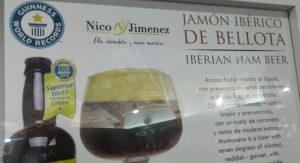
We rushed our visit to Mérida so we could get back to the finca before it got too dark – but there are numerous other Roman bridges and things to see – including a large Moorish complex we were unable to visit.
On Monday, 22 January, we drove up into the mountains to visit the town of Montánchez. Not a lot to talk about, other than the place is packed with wholesale Jamon Iberico de Bellota outlets. These are the fabled Spanish hams taken from pigs grazing on acorns gathered from Dehesa floors. I had heard of DO (Domaine de Origine) designators for wine, cheese and olives, but not until now did we see one for Ham. They also have one of the nicest cemeteries in Spain, with a spectacular view of the valley below, and dominated by an old castle above. Unfortunately, the valley was obscured by fog on this day, but here’s a pic of the castle.
Tuesday after work, we headed for Medellín, a town of about 2500 inhabitants notable for its Roman amphitheater (not so well restored as in Mérida) and as the birthplace of the conquistador Hernán Cortés, conqueror of the the Aztec civilization in present day Mexico.

In the town plaza is a statue of Cortes with his foot on the head of one of his unfortunate opponents.
This must have been old conquistador week, because on Wednesday, we went to Trujillo, birthplace of Francisco Pizarro, who conquered the Inca Empire in present day Peru. Pizarro was murdered by some of his colleagues, but his relatives returned to Trujillo with fabulous wealth and built some really nice houses.
Thursday night, Roy had to phone some colleagues in the states, and Teresa went with some friends to an art opening in Caceres. The artist’s name was Miguel Sansón – a student of Iva’s and also from Almoharin. While at the opening, Teresa met a woman who stood out because of her incredibly blue hair. It turns out that Lucia Bosé is an extremely well known actor in Europe, and that’s why she was being treated like royalty at the show. 
On Friday after lunch, we packed up our rental car and headed southeast towards Cordoba. But before we drove out the gate of Finca Flores Amarilla, Teresa took one last photo: 
What fun! So are you like singing for your supper with all that making stuff for your hosts?
Exactly! Working for room & board! Kind of reminds me of working on that farm in Bavaria back in the early 70’s … except they paid me a couple DM/day in addition to room & board.
— Roy